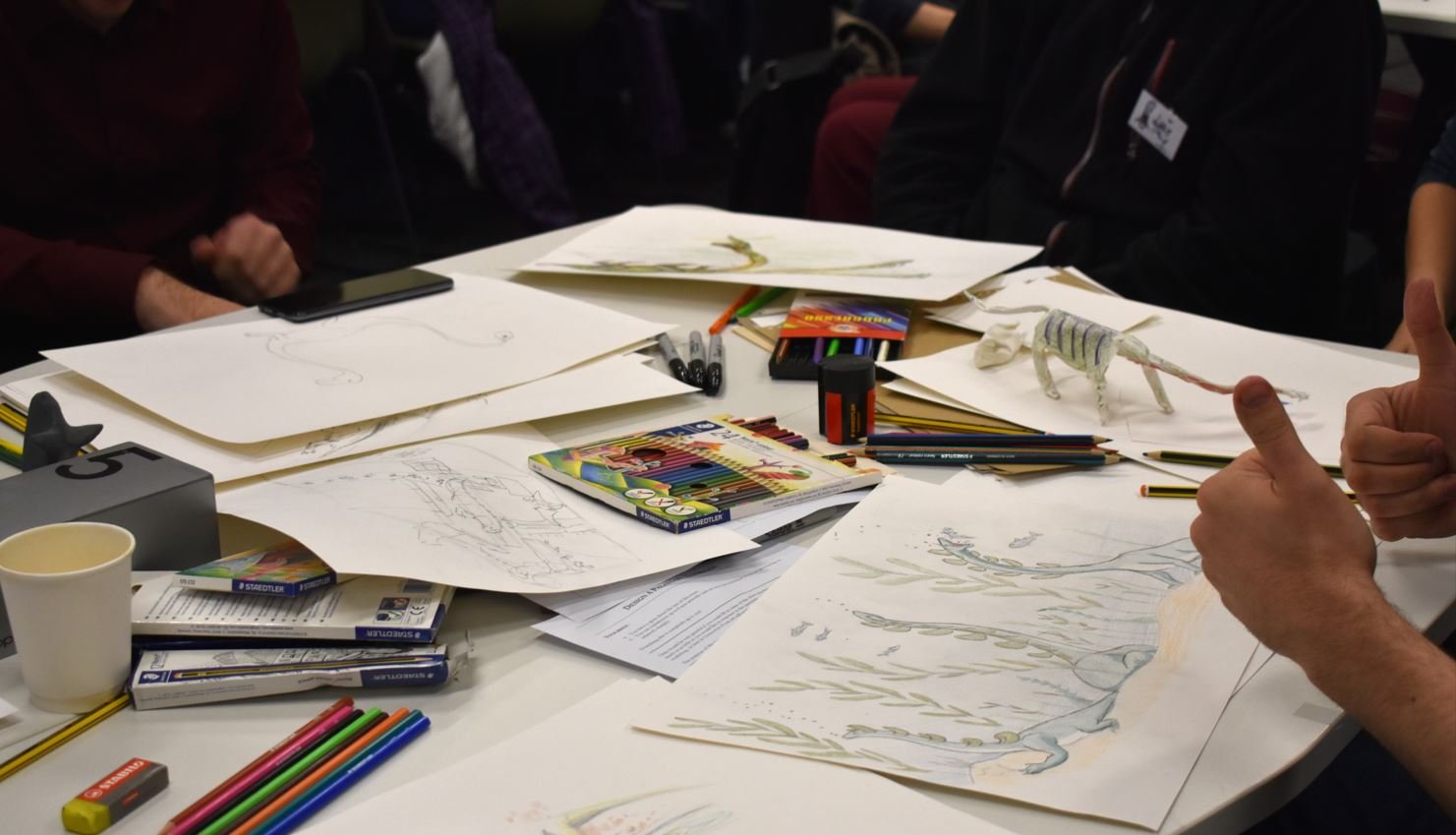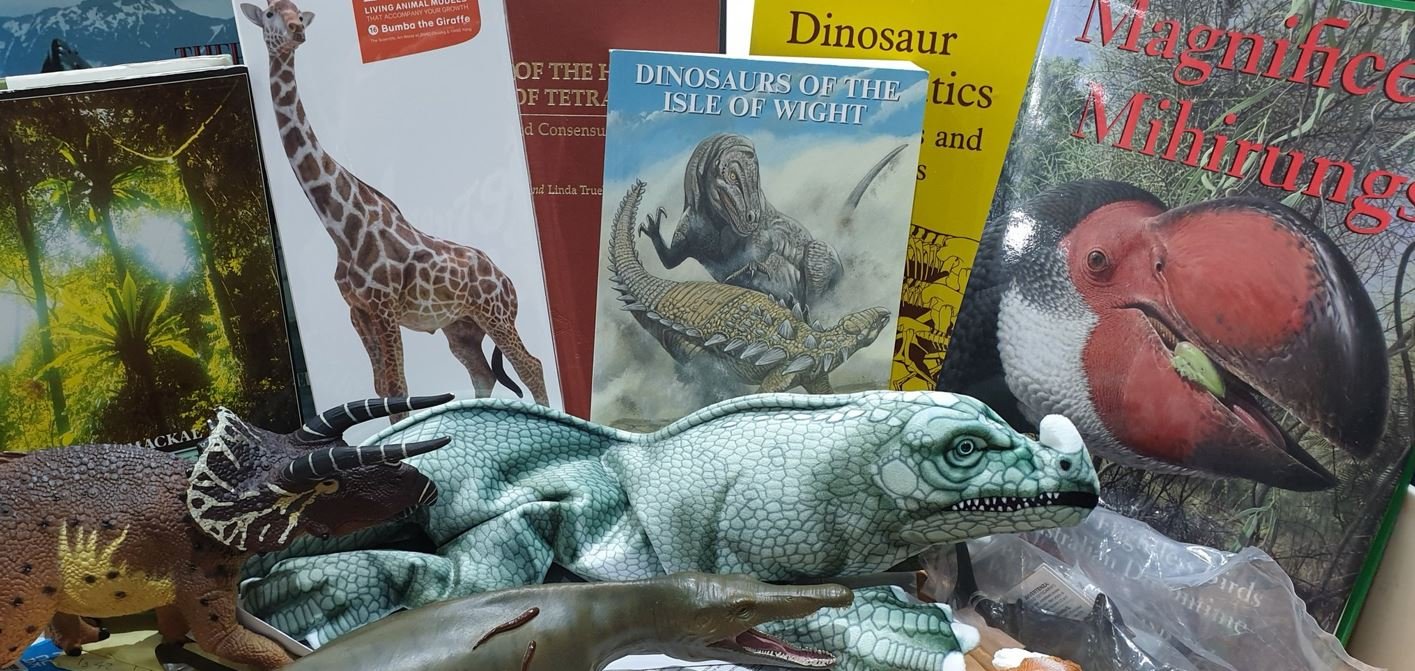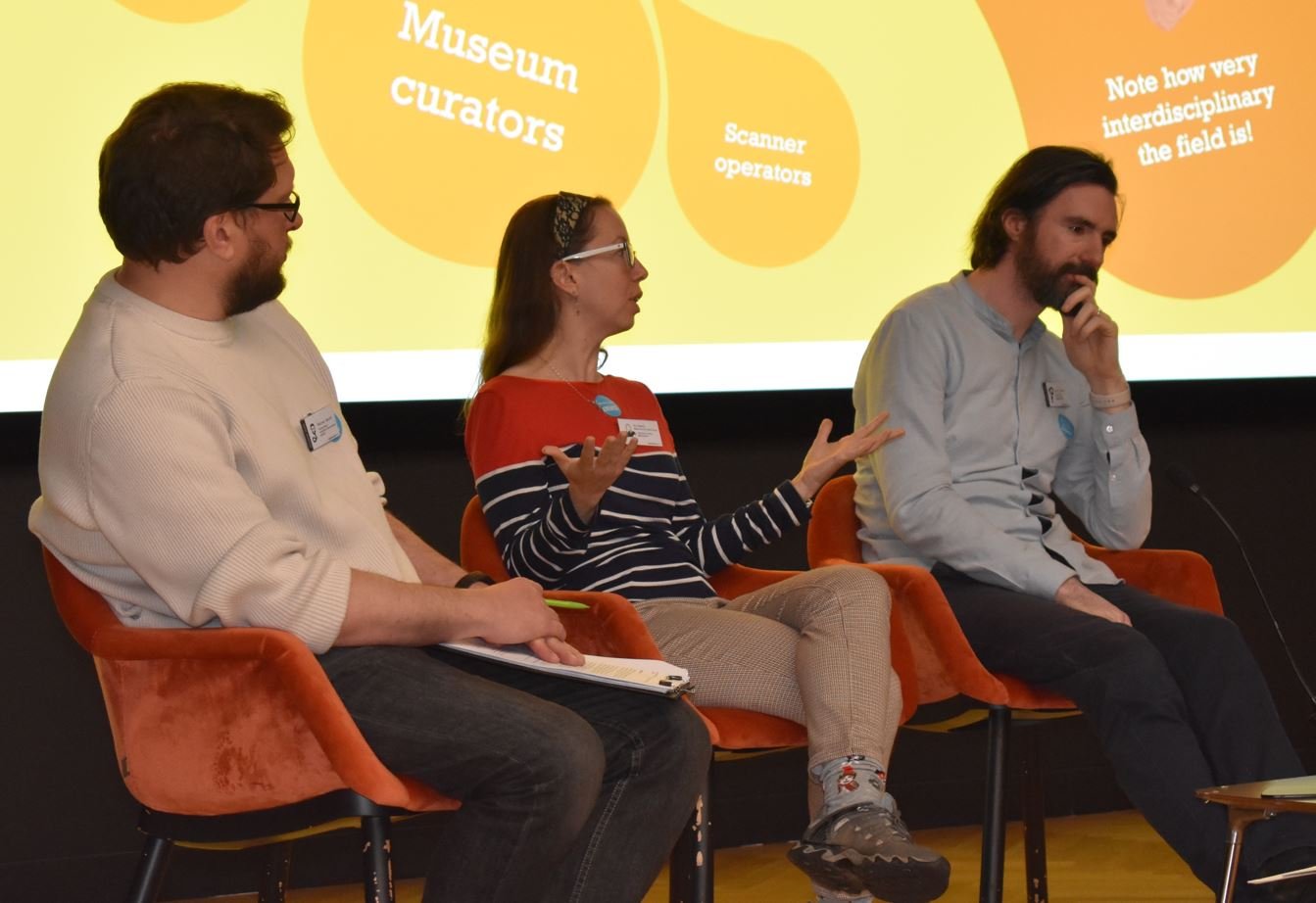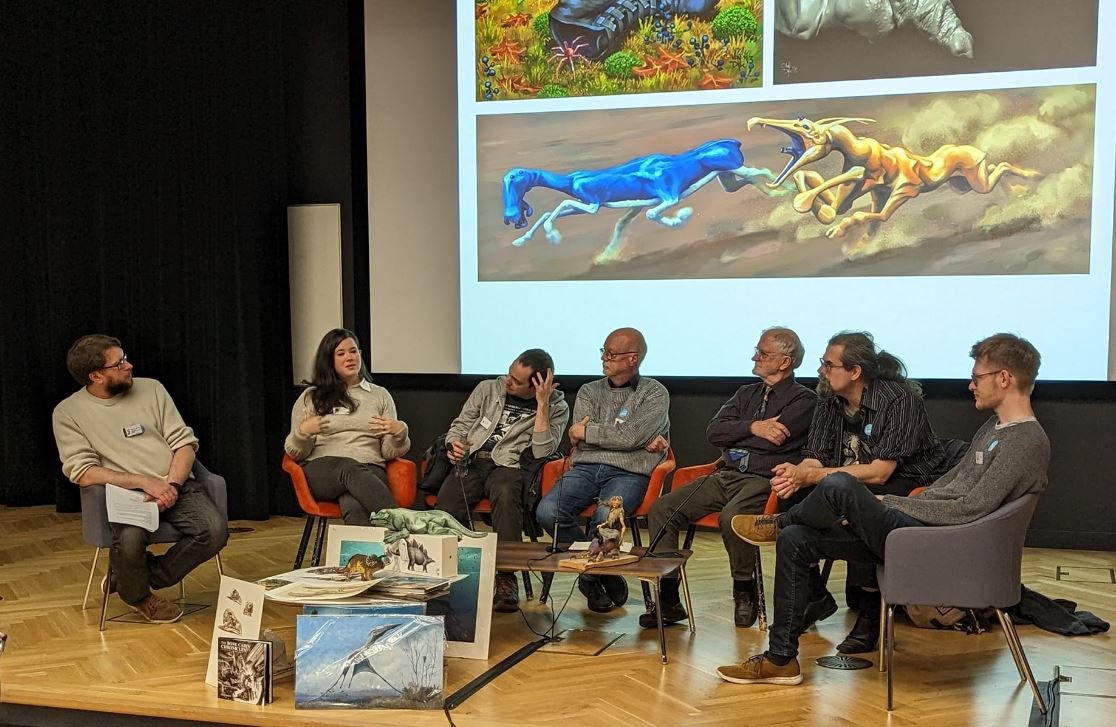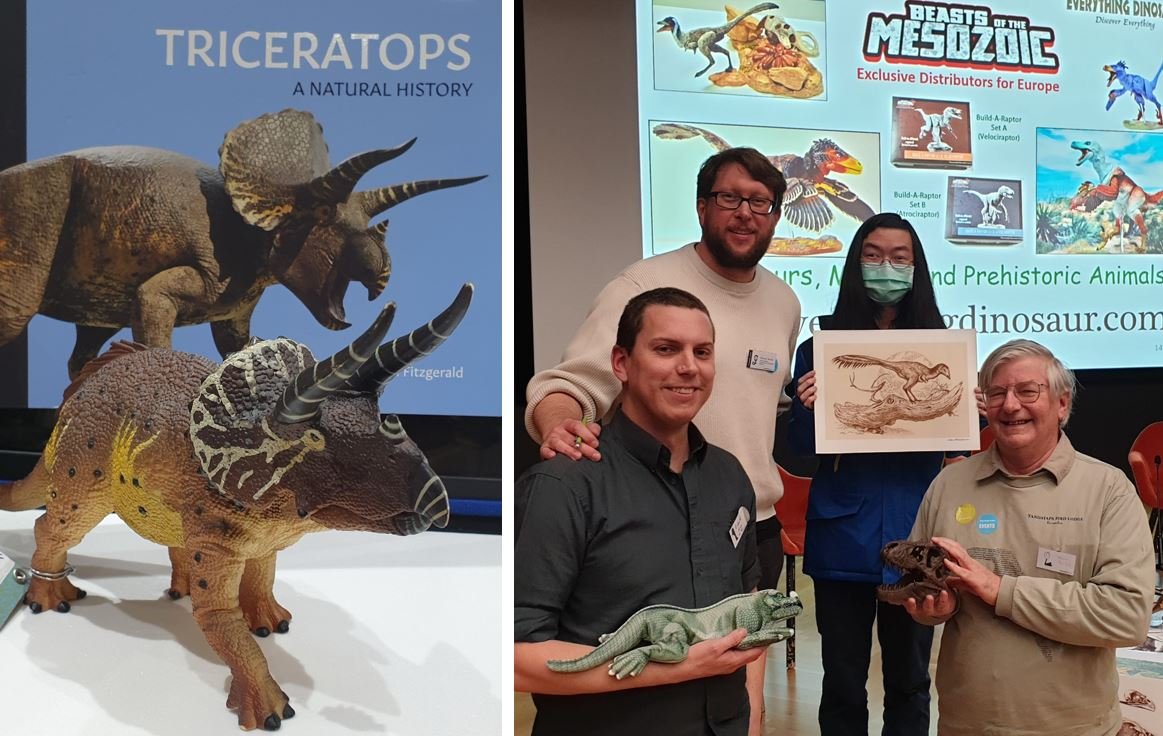TetZooCon 2022 just happened. How did it go? Well, it went pretty well is how it went…
Caption: at upper left, a Prehistoric Planet-style Mononykus plush by Leo; at lower left, an origami Triceratops by Joel Colbourne; TetZooCon badges in the middle; and our amazing venue – Bush House – at far right. Images by Darren Naish.
On Saturday 3rd and Sunday 4th December 2022, around 200 people gathered in London for the year’s Tetrapod Zoology Convention, the first in-person of our events we’ve held since 2019.
I’ll start by staying that our venue – Bush House, King’s College, The Strand, London – was amazing and just about perfect for our needs. The auditorium was spacious and modern (it even had balconies and a green room) with good acoustics, the reception area was good and appropriately nearby, and there were convenient amenities within very short walking distance. Enormous thanks to Chris Manias of King’s College for working with us in setting up Bush House as a venue: excellent work, and it looks like we’ll be there again in 2023. Before proceeding, I also need to mention that we have an official photographer at TetZooCon: Georgia Witton-Maclean. Huge thanks to her for the photos and for passing them to me in good time.
Caption: our banner this year was squamate-themed… for no particular reason at all.
Platypus Matters and Locked in Time. Our opening talk was one of my favourites: Jack Ashby’s Platypus Matters: the Extraordinary Story of Australian Mammals. Jack reviewed the history of platypus science and knowledge before surveying marsupial diversity and some of their remarkable specialisations. Emphasised throughout was the fact that these animals – monotremes and marsupials – shouldn’t be assumed to be, or be framed as, weirdos or primitives, as is tradition within the Eurocentric world. Jack’s talk was accompanied by the selling and signing of his excellent new book: Platypus Matters (Ashby 2022).
Caption: Jack Ashby presents Platypus Matters, also the name of his new book. Image: Georgia Witton-Maclean.
Jack was followed by Dean Lomax on Locked in Time: Unearthing the Behaviours of Prehistoric Animals, another talk connected to a new book (Lomax 2021). Dean explained his own background and his involvement in research on extraordinary fossils, some of which depict ‘frozen behaviour’ of the sort described in his talk and book. Amazing stuff: think mammoths locked together in combat (I wrote about them back in 2008), fighting dinosaurs, ichthyosaurs giving birth. An amusing connection with Jack’s talk – and Dean drew attention to this – is that both of them used the mass annual death of male antechinuses as an example of an extreme behaviour. Dean’s talk was also followed up by a selling and signing event.
Caption: the tangled mammoths. Amazingly, this association has not been properly described in the academic literature (come on, mammoth experts: what are you doing with your time?). At right, Dean Lomax’s excellent new book Locked in Time, featuring art by Bob Nicholls.
A third speaker of that planned opening session (Hana Ayoob) was unfortunately unable to join us; hopefully we’ll be able to host her in the near future.
All Yesterdays, ten years on. 2022 marks ten years since the publication of the palaeoart-themed book All Yesterdays. Accordingly, it seemed appropriate to have an All Yesterdays event at TetZooCon 2022 whereby the book’s three architects – myself, John Conway and C. M. Kösemen – discussed aspects of its creation and formation on stage. Maybe it was a little less structured that it should have been, but it seemed to be enjoyed, and provided a bit of context and background to the project. One takehome is that its completion was rushed and involved a lot of provisional decisions and short-cuts.
Caption: at left, Memo Kösemen at his TetZooCon 2022 stall, with art prints (and originals) for sale. Note the All Yesterdays and Squamozoic art (and more) stuck on the column. At right, Naish, Kösemen and Conway on stage during the All Yesterdays event. Images: Georgia Witton-Maclean.
I kicked things off by running through – at speed – the talk I delivered at the original launch event of 2012. We had copies of All Yesterdays on sale at TetZooCon 2022 and at least a few people got all three of us to sign them; Memo also sold – yes, sold – a fair amount of original All Yesterdays artwork. I would have bought some but never had time to sort it out.
Caption: Memo Kösemen signing and selling art at his TetZooCon 2022 stall. Image: Georgia Witton-Maclean.
Palaeoart Workshop. Next up, our parallel session began. One group of people attended the Palaeoart Workshop, and another a talk session. I didn’t attend the Palaeoart Workshop so I don’t know exactly what happened, but I do know from photos I’ve seen that a whole lot of art was produced. The workshop this year incorporated a meeting of Chris Manias’s Popularising Palaeontology event, the result being a discussion of exhibition design. Led by John Conway, the group also had fun in depicting the radically unusual Triassic reptile Tanystropheus in innovative ways.
Caption: a table-top scene from the TetZooCon 2022 palaeoart workshop. Image: Georgia Witton-Maclean.
Cockatoos and other theropods, and the British herpetofauna. The talks happening at the same time kicked off with Could Ancient Theropods Use Tools? from Jennifer Colbourne. Jennifer’s PhD is mostly on cockatoos and their tool-using and problem-solving abilities, and wow it’s interesting. Does Jennifer think that Mesozoic dinosaurs could have used tools? She focused on troodontids in particular – for obvious reasons – and kindly plugged my 2021 Dinopedia as her primary source of information on Mesozoic dinosaurs; ha ha, how kind. Anyway… the tool-use thing is not especially likely based on what we know right now.
Caption: Jennifer Colbourne talks about cockatoos and her research on their intelligence and use of tools, and on tool use in non-human animals in general. Image: Georgia Witton-Maclean.
Next up, we had a Mesozoic theropod-focused talk from Cassius Morrison. The idea that spinosaurids were fish-eaters is well known, but what about their relatives the megalosaurids? New data relevant to niche partitioning and diet in Jurassic and Cretaceous theropods of various sorts was discussed; this work forms the focus of Cassius’s PhD and I look forward to seeing it out there in print.
The final talk in the session was by myself and concerned Neglected Natives and the Reptiles and Amphibians of Britain’s Past. I’ve given this talk a few times before and have written about a few of the specific issues here at Tet Zoo over the years: it concerns such things as the loss of the UK’s native Pool frogs Pelophylax lessonae, arguments that the Common treefrog Hyla arborea might be a British native, and the saga of the Bournemouth green lizards.
Caption: one of the TetZooCon organisers discusses aspects of the British herpetofauna. I’ve always planned to write up the contents of this talk. But so far I haven’t. Image: Georgia Witton-Maclean.
Palaeoart, cosplay and stalls. Speaking and presenting events over, we moved out of the respective rooms and back to the reception area where our art exhibition and drinks reception happened. I didn’t drink too much wine, but I don’t remember all the art on show: it combined palaeoart (including the work of John Conway, Rebecca Gelernter, Natalia Jagielska, Joschua Knüppe, Joanna Kobierska, Luis Rey, Jed Taylor, Gert van Dijk and Steve White) with some academic-leaning anatomical reconstruction work (Matt Dempsey), book showing and plushy representation.
Caption: pictures taken at the TetZooCon 2022 art exhibition. At left, James McKay with a selection of small colour images produced for Palaeontological Association outreach events (children create prehistoric animals from jumbled bits and pieces, and James then illustrates these creations as real-looking animals). At right: Gert van Dijk with a selection of images relevant to his Furaha project. Images: Georgia Witton-Maclean.
Caption: at left, palaeontologist and PhD student Matt Dempsey with his poster on dinosaur reconstructions. At right: a famous internet image incorporating Philip Hood art from Man After Man, now existing as a physical Christmas card that was gifted during TetZooCon 2022 to Dougal Dixon. Images: Darren Naish.
Caption: Rebecca Gelernter art at TetZooCon 2022. Very pleased to see her there.
If you’ve been paying attention, I’ve been saying for years that I’d welcome cosplay at TetZooCon (I owe this idea to Rebecca Groom). We’ve never really got it going though. And then along came Meghan Jenkinson, who just happened to have an Ellie Sattler outfit with her. She wore it during the Saturday evening – and almost instantly we had a full Jurassic Park cosplay event on our hands. Which is great. I need a make a few enquiries, but I essentially reckon that we should lean hard into this and have a cosplay event – with accompanying competition – at the TetZooCons of the future. Watch this space.
Caption: all of a sudden - - - Jurassic Park cosplay! Image: Darren Naish.
I haven’t much mentioned the stalls and merchandise we had at TetZooCon 2022. I think we had a pretty good spread of art (both prints and originals), merch like stickers and pin badges, and books on sale. Sales were good, and I basically hope that we can expand the number and diversity of stalls we have in the future. I took along a good list of books I needed to sell (including several sought-after semi-academic texts) and did so via a silent auction. Thanks to Joanna, Natalia, Friends of the Crystal Palace Dinosaurs, Luis Rey, Jed Taylor, Steve White, Mark Witton and the others who hosted stalls.
Caption: thanks to the Friends of Crystal Palace Dinosaurs, I discovered and obtained these excellent enamel pin badges. They’re made by Joseph Fells and are available at BleachedBonesStore.etsy.com.
Caption: various of the items that featured in the silent auction and quiz. Massive thanks to everyone who played along and took part. Image: Darren Naish.
What happened at the end of day 1, after the drinks reception? I have no idea but I remember waking up in a taxi at some point during the night.
And thus day 2 began. Hangover, what’s a hangover? The day consisted of five separate things: the pterosaur event, the Mesozoic Art signing event and its associated talk, the ‘designing aliens’ roundtable, the Crystal Palace talk, and the quiz.
The pterosaur session. I would have loved it if we’d done, say, a whole day, or a whole half a day, dedicated to pterosaurs – the membranous-winged flying cousins of the dinosaurs – but, in the end, a couple talks were still great. At last, I succeeded in getting my long-serving friend and colleague Liz Martin-Silverstone to attend and speak at TetZooCon (kidding, Liz has been busy or unavailable on the years I’ve asked). Liz’s talk was Why You Should (or Shouldn’t) CT Scan a Pterosaur. She discussed the ups and downs of CT-scanning and her own relevant studies, including the paper we co-authored on locomotor abilities and pterosaur sacral anatomy: Martin-Silverstone et al. (2018).
Caption: Liz Martin-Silverstone opens our special pterosaur session and asks the important questions. Image: Georgia Witton-Maclean.
Natalia Jagielska was up next with From Stone to Bone: a Step by Step Guide to Describing Your Own Pterosaur. It was much more than a retelling of the Dearc story (Dearc is a Middle Jurassic pterosaur from Scotland, described by Natalia and colleagues earlier this year: Jagielska et al. 2022) but actually a good guide to the entire process whereby fossil species are discovered, studied, published and incorporated into human knowledge and culture thereafter. Memes, gifs, joke captions… Natalia is a highly entertaining speaker!
Caption: the Natalia Jagielska stall. I understand that Natalia sold nearly all of the merch and art she bought along. Image: Agata Stachowiak, used with permission.
Liz and Natalia then joined me on stage – together with Mark Witton and John Conway – for the pterosaur roundtable event. I think it went well. We discussed current thinking on pterosaur integument and wing membrane anatomy, public misconceptions about pterosaurs, and our favourite pterosaurs (interestingly, we essentially all chose different groups) before taking questions from the audience. Natalia was accompanied by her trusty Dearc plushie (made by Rebecca Groom of Palaeoplushies fame) and had the opportunity to use it as a model when discussing pterosaur anatomy.
Caption: our pterosaur roundtable, as seen from the audience. Left to right: Darren Naish, Liz Martin-Silverstone, John Conway, Natalia Jagielska, Mark Witton. Image: Agata Stachowiak, used with permission.
Caption: another pterosaur roundtable, showing (l to r) Darren, Liz and John. Image: Georgia Witton-Maclean.
A last-minute schedule modification meant the addition of an extra talk at this point in the schedule: John Conway’s A History of A History of Painting (With Dinosaurs). This accompanied John’s book A History of Painting (With Dinosaurs), officially launched a couple of weeks ago (I missed that launch due to being in the USA or something), and good fun it was too. The book was on sale at the event – I know John sold them all because there were none left when I went to steal one. I mean buy one.
Caption: John Conway presents A History of A History of Painting (With Dinosaurs), on his new book A History of Painting (With Dinosaurs). Image: Georgia Witton-Maclean.
Onto the Mesozoic Art section. Steve White – the man, the legend – discussed Herding Cats: How to Publish a Palaeoart Book, a review of Steve’s involvement in palaeoart publishing. Steve might be seen as a ‘community hub’ today, but his initial entry into the area was tenuous and included a lot of luck. He also provided some cautionary tales on what works and what doesn’t when it comes to publishing. Niche books with unusual, complex titles (a hypothetical ‘Palaeoenvironments of the Mesozoic’ was chosen as an example) essentially won’t succeed if you take them mainstream.
Caption: Steve White discusses Mesozoic Art and its backstory. Image: Agata Stachowiak, used with permission.
The Dinosaur Art books from Titan have to be considered among the most successful palaeoart-themed works ever, and 2022’s Mesozoic Art is a sort of descendant of those books. Steve explained how thanks were owed to Jim Martin at Bloomsbury for setting things up, and I’m pleased to say that Jim was in attendance.
We moved on to the signing event. The fact that seven contributors to the book – Steve, myself, John Conway, Joschua Knüppe, Joanna Kobierska, Jed Taylor and Mark Witton, plus the publishers – were present at TetZooCon 2022 means that it was the closest thing we’ve had to an official launch-type event. Copies were sold throughout the whole of TetZooCon, such that I think all copies were bought (and hopefully all signed) by the end of the signing event.
Caption: one of the tables in the Mesozoic Art signing event (there were… three such tables, I think). Those doing the signing here are (left to right) John Conway, Mark Witton and Steve White. Image: Georgia Witton-Maclean.
Designing Aliens. Next, a (mostly different) set of seven people gathered on stage for a roundtable discussion on the designing of hypothetical aliens. What do we like, what do we not like, what possibilities exist, and what sort of projects are people working on? The event was co-led by myself and Gert van Dijk (of Furaha) and featured Jennifer Colbourne, Dougal Dixon, C. M. Kösemen, Joschua Knüppe and Adrian Tchaikovsky.
Caption: a scene - taken from my position on stage - of the designing aliens roundtable, showing (l to r) Gert van Dijk, Dougal Dixon, Adrian Tchaikovsky and Joschua Knüppe. Dougal is holding a Greenworld model; a woman (equipped with animal skins and other products manufactured from endemic wildlife) is riding a large, vaguely conch-like terrestrial animal. Image: Darren Naish.
Caption: the designing aliens panel event as seen from the audience. Left to right: Darren Naish, Jennifer Colbourne, Memo Kösemen, Gert van Dijk, Dougal Dixon, Adrian Tchaikovsky and Joschua Knüppe. Image: Agata Stachowiak, used with permission.
Dougal bought along models constructed for his Greenworld project (still not published in English), Memo had original Snaiad artwork with him, and Adrian told us about his intelligent giant spiders. A question from Frank Drake’s grandson – yes, Drake Equation Drake – inspired us to consider how likely ‘human mimicry’ would really be when it comes to biological diversity in the universe. Interestingly, panel members mostly agreed that we shouldn’t assume a human-like form (even at the superficial level) in an intelligent alien, a view I strongly agree with. I would be interested in knowing whether people would have said similar things in a discussion panel 20 years ago, or 40 years ago.
Caption: more from the designing aliens roundtable, this time with images from Dougal Dixon’s Greenworld project on the screen behind us. Image: Georgia Witton-Maclean.
Anyway, the panel was over all too quickly – it was obvious that we could have talked for another hour… though it doesn’t necessarily follow that the audience would have been as enthusiastic as we were.
The Crystal Palace talk. Sunday wrapped up with the excellent talk The Art and Science of the Crystal Palace Dinosaurs: Changing the Narrative by Mark Witton and Ellinor Michell, which was again followed by a book signing. The new arguments about the prehistoric animal models of Crystal Palace put forward by Mark and Ellinor are now fairly well known (among those interested in palaeoart, anyway). The models represent a major triumph of design, construction and anatomical depiction, the role of Richard Owen is mysterious and likely minimal at best, and the relationship that the models have with mainstream science and science advocacy is complex and always have been. One of the most exciting discoveries that stems from Mark and Ellinor’s work is that some number of the original models have been entirely lost, a fact wholly unrecognised until now (Witton & Michel 2022).
Caption: Mark Witton and Ellinor Michel on stage at TetZooCon 2022. Buy the book, it’s amazing. Image: Georgia Witton-Maclean.
Caption: slide from Mark and Ellinor’s talk, in this case focusing on the anatomy of the anoplotheres on show at Crystal Palace. What’s with the comparison between the anoplothere model and the shaking pet dog? You should check Witton & Michell (2022) for an explanation… Image: Agata Stachowiak, used with permission.
Be sure to get Mark and Ellinor’s book – The Art and Science of the Crystal Palace Dinosaurs (Witton & Michel 2022) – if you haven’t already. I feel compelled to add that I’ve written about the Crystal Palace models a few times here at Tet Zoo myself, most relevantly at Up Close and Personal With the Crystal Palace Dinosaurs.
Next up: time for the quiz. 30 questions of varying complexity, all on matters relating to the TetZooniverse, were put to the audience. They included the storylines of Primeval, zebra subspecies, the dispersal abilities of mink and Dr Alan Grant’s biography. Albert Chen got the highest score and thus first pick of the prizes, Kelvin Britton came next, then Richard Hing (all three have scored extremely highly or won in previous years). A remarkable number of excellent prizes – books, animal figures, plush toys, art prints, replicas and more – were available; massive thanks to those who donated them.
Caption: we had a selection of excellent quiz prizes. This large CollectA Triceratops and the accompanying book (authored by Erich Fitzgerald) were kindly provided by Jack Perkins and Melbourne Museum. At right: the three highest-scoring quiz players and myself. Images: Darren Naish, Hel Naish.
I should add here – mostly because I don’t know where else to put it – that we had several podcasting teams present at TetZooCon 2022, and they were essentially given free rein to record interviews with people throughout the event. I look forward to see—hearing the results; we couldn’t record the events of TetZooCon 2022 with cameras but at least some material from the meeting will exist in audio form. Having said that things weren’t recorded, there are at least a few brief videos: check out this one. I like it a lot.
Caption: Natee Himmapaan kindly provided this print of a Prehistoric Planet-inspired Mononykus (I also now own one myself). At upper right we see the diminutive, exquisite original in Natee’s drawing book.
We went to a large pub on Sunday night. Gone are the days where we can find a restaurant large enough to cater for us in cost-effective manner. Anyway, I think we had a good time. I got corralled in by a gang of Prehistoric Planet fans who refused to let me escape until I’d answered 240 questions about Prehistoric Planet. Ha ha, I kid, I kid, it was all good and I feel the love.
Caption: a beautiful day to visit the Crystal Palace dinosaurs. We see the two Iguanodon (which are no longer actually Iguanodon at all) at left, the Hylaeosaurus at right, and one of the two large pterosaurs (noawadays: Cimoliopterus) in the background. Image: Darren Naish.
To Crystal Palace. And so to Monday, the final day: the fieldtrip to Crystal Palace day. Bad weather threatened to ruin things, but in the end we had a bit of light rain and nothing more. More problematic was the fact that tall metal fences, locked gates and other barriers barred all entry to the park when we arrived. Various men in hi-viz coats assured me that entry wouldn’t be possible for a day or two, so it’s fair to say that I was a bit frustrated at this point. In the end, none of it made that much difference: entry was still possible via other routes.
Caption: group 2 look at the Crystal Palace Megalosaurus. Image: Darren Naish.
I did my best to swot up on the new ideas and discoveries covered in Mark and Ellinor’s book, and thus told my group a bunch of new stuff about anoplotheres and palaeotheres, about the missing Xiphodon and the Megaloceros fawn that isn’t, about the enigma of the megathere’s hands and so on. And if you want to know what I’m talking about, you’ll need to obtain the book (Witton & Michell 2021). The conditions were beautiful for photography, and we were essentially done by around 3pm.
Caption: more from the Crystal Palace fieldtrip. At left, the ‘Megaloceros fawn’, now known to be the last surviving Xiphodon. At right: your blog’s author with the original Hylaeosaurus head, today relocated on a mound above the main part of the geological court (the actual Hylaeosaurus model has a fibreglass replica for a head). Images: Darren Naish, Hel Naish.
And that’s that. TetZooCon 2022 was the biggest of our meetings so far; I’m so pleased with how it went. It was the NINTH TetZooCon, meaning that the 2023 one has the potential to be something bigger and more unusual than… usual. There’s already talk about things that might be arranged for 2023 but all I can say for now is watch this space, variously here at the blog, at the TetZooCon facebook page, or via # TetZooCon on twitter… or whatever social media platform is appropriate (I’m on mastodon but don’t use it much).
Finally, thanks as ever to my co-organisers and assistants – John, Jenny, Hel, Georgia, the staff at King’s College – and in particular to Chris Manias for access to the venue. Huge thanks to all the speakers, presenters, those with stalls, and of course to all the attendees. Another substantial success, and here’s to the TENTH event next year!
For previous articles on TetZooMCon and TetZooCon, see…
The events of TetZooCon 2014, July 2014
TetZooCon 2015 Is On, July 2015
The Events of TetZooCon 2015, November 2015
Coming Soon: TetZooCon 2016, September 2016
The Day After TetZooCon, October 2016
The Fourth TetZooCon, September 2017
The TetZooCon of 2017, October 2017
Reasons to Attend TetZooCon 2018, September 2018
TetZooCon 2018: Best TetZooCon So Far, October 2018
Announcing TetZooCon 2019 – the Biggest Yet, August 2019
Final Call For TetZooCon 2019, October 2019
The Sixth TetZooCon, October 2019
TetZooCon 2020 + Zoom = TETZOOMCON 2020, December 2020
TetZooMCon 2020 an Unbridled Success, December 2020
Cronch Cats, Beasts of Gévaudan, Dinosauroids, Mesozoic Art and Much More: TetZooMCon 2021 in Review, September 2021
Refs - -
Ashby, J. 2022. Platypus Matters: the Extraordinary Story of Australian Mammals. The University of Chicago Press, Chicago.
Lomax, D. R. 2021. Locked in Time: Animal Behavior Unearthered in 50 Extraordinary Fossils. Columbia University Press, New York.
Witton, M. P. & Michel, E. 2022. The Art and Science of the Crystal Palace Dinosaurs. The Crowood Press, Marlborough.







